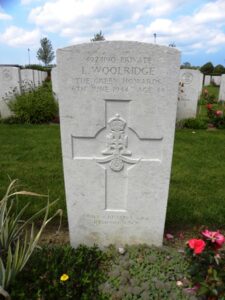The village of Crymych sits at the north of the County of Pembrokeshire. It developed around the Crymmych Arms Railway Station, which sat on the line from Whitland to Cardigan. The Parish of Crymych covers the nearby villages of Eglwyswrw, Blaenffos, Llanfyrnach, Hermon and Glogue, and the names on the Crymych Memorial cover the men from the entire Parish. Several of these men have since been added onto the new Eglwyswrw War Memorial.
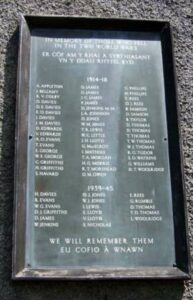
The Great War, 1914-1918
George Appleton, Private, 5925, Royal Berkshire Regiment. George was born at Blewbury in Berkshire, the son of William and Jane Appleton. He married Louisa Jones Chown in Cardigan in 1909, and the couple set up home at Rhosfach, Blaenffos, Pembrokeshire. George was a regular soldier, serving with the 1st Battalion, Royal Berkshire Regiment, which was stationed at Aldershot, with 6 Brigade, 2nd Division. George arrived in France with the Battalion on 13 August 1914, and took part in the retreat from Mons to the Marne. The Germans retreated north, and the BEF met them, fighting at the Battle of the Aisne. The 2nd Division were then moved to Flanders, where they fought at the First Battle of Ypres, when the German sweep through Flanders was stopped, and remained there throughout the first winter of the war. In 1915 they took part in the Battle of Festubert. George was killed here on 11 March 1915. He was 33 years old, and is buried at Guards Cemetery, Windy Corner, Cuinchy, France.
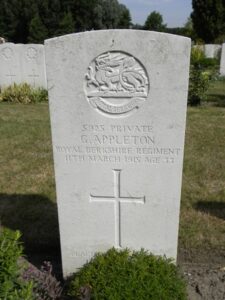
John William Bellamy, Private, 116552, Machine Gun Corps. John was born in Boston, Lincolnshire in 1898, the son of Frederick William Bellamy and Rebecca Bellamy. By 1911 the family was residing at Cilgwyn, Boncath, where Frederick worked as a Gamekeeper. John enlisted at Carmarthen into the South Wales Borderers, with the Service Number 202014, but after training was transferred into the 9th Company, Machine Gun Corps. He was probably posted to France during the summer of 1917, where his Company was attached to 9 Brigade, 3rd Division. The Division had been in France since the outbreak of war, and John joined his unit at Ypres. The division fought in the Third Battle of Ypres, at the Battle of the Menin Road and the Battle of Polygon Wood. In November the Division moved south, and fought at the Battle of Cambrai. It was still in the area on 21 March 1918 when the German Spring Offensive swept through the British lines, and took part in heavy fighting over the coming days. The battered Division was moved to Flanders to rebuild, but the Germans switched the focus of their offensive to Flanders and the Division was caught up in heavy fighting again in the Lys valley. John was killed in action during the Battle of Kemmel on 25 April 1918. He has no known grave, and is commemorated on the Tyne Cot Memorial, Belgium.
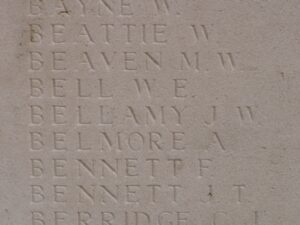
Lawrence Robert Vaughan Colby, Major, Grenadier Guards. Lawrence was born on 3 April 1880, the only son of John Vaughan Colby, of Ffynone, Pembrokeshire, and Anne Harriet Colby. Lawrence was a pre-war regular in the Army who had served during the Boer War. By the outbreak of the Great War he served as a Major with the 1st Battalion, Grenadier Guards, which was attached to 20 Brigade, 7th Division. The Division was formed during September, 1914 and landed at Zeebrugge on 6 October, 1914. The City was already falling however, and so the Division was moved to Ypres, where they became the first British Division to hold the city. They fought during the First Battle of Ypres, and helped stop the German advance through Belgium. Lawrence was sadly killed in action at Ypres on 24 October, 1914. He was 34 years old, and has no known grave, and so is remembered on the Ypres (Menin Gate) Memorial, Belgium.
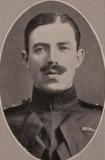
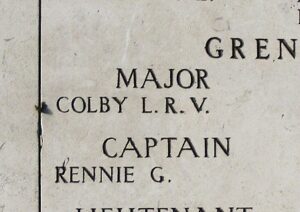
Daniel Davies, Private, 204772, Kings Liverpool Regiment. Daniel was the son of David and Sarah Davies, of Glynsaithmaen, Llangolman. He resided at Cilgerran prior to the war. He enlisted at Cardiff into the Army and joined the Royal Welsh Fusiliers, with the Service Number 43014. Daniel then transferred into the 8th Battalion (Liverpool Irish), King’s Liverpool Regiment, which was attached to 165 Brigade, 55th (West Lancashire) Division. The complete Division was reformed around Hallencourt in France during January 1916, relieving the French 88th Division south of Arras by 16 February. It was familiarised into trench warfare here before moving south in July and took up a place in the front line opposite the village of Guillemont. Here the division fought at the Battle of Guillemont and the Battle of Ginchy. There was a short period of rest at Ribemont from the 12th to the 17th September, and then the division fought at the Battle of Flers-Courcelette and the Battle of Morval. Relieved by 41st Division on 28 September, the Division withdrew to the area of Buire and Ribemont, before relieving the 29th Division in the Ypres salient in October 1916. It was destined to remain in this area for almost a year, stationed near Railway wood. At the end of July 1917 the Division fought at the Battle of Pilckem, and this is where Daniel was killed on 31 July 1917, aged 24. Daniel has no known grave, and is commemorated on the Ypres (Menin Gate) Memorial, Belgium.
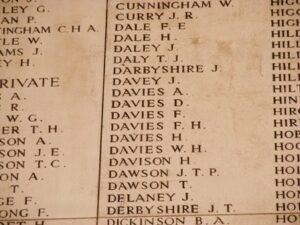
David Evan Davies, Private, 56738, Welsh Regiment. David was the son of David and Margaret Davies, of Tywyn, Bridell, Cardigan, and was the husband of Elizabeth Blodwen Davies, of Trebared Farm, Cardigan. He attended Rhoshill Council School prior to the war. David served with the 3/7th Battalion, Welsh Regiment, which was a Reserve Battalion. David then joined the 14th (Swansea) Battalion as reinforcement on 30 July 1916 after the hammering they had suffered at Mametz Wood. The Battalion had moved to Ypres with 114 Brigade, 38th (Welsh) Division, to rest and refit after their mauling in capturing Mametz Wood, and took up positions north of Ypres, along the Boesinghe section of the Canal. David was wounded here, and sadly died as a result at the 129th Field Ambulance on 13 September 1916. He was 28 years old and is buried at Essex Farm Cemetery, Belgium.
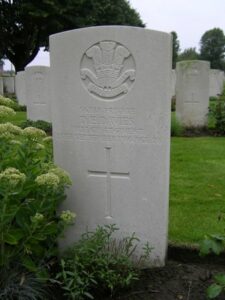
Evan Owen Davies, Corporal, 30370, Middlesex Regiment. Evan was born in Eglwyswrw. He resided at Esgyrnfawr, St. Dogmaels prior to the war, and enlisted into the Middlesex Regiment, with the Army Number 156. He transferred into the 46th Company, Machine Gun Corps, which was created by Royal Warrant, on 14 October 1915. Evan’s Company became attached to the 15th (Scottish) Division from 11 February 1916 onwards. The Division fought in the latter stages of the Somme Battles of 1916, and were in the middle of the Battle of Le Transloy when Evan was killed in Action, on 13 October, 1916. His body was lost on the Somme Battlefield, and so he is commemorated on the Thiepval Memorial.
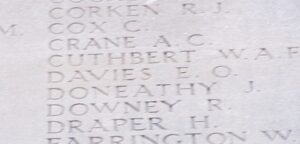
John Davies, Private, 201439, Welsh Regiment. John was the son of James Davies, of Frondeg, Glogue. He enlisted at Carmarthen into the 1/4th Battalion, Welsh regiment during August 1914, and the Battalion later joined 159 Brigade, 53rd (Welsh) Division. The Division moved to the Mediterranean, sailing from Devonport in July, 1915 arriving at Mudros by the 5 August 1915. From here they moved to Gallipoli, landing on 9 August. Here they immediately faced the chaotic leadership that was to lead to the ultimate failure of the campaign, and spent the next few days in isolated pockets, fighting against a Turkish counter-attack during the Battle of Sari Bair, and then at the Attack on Scimitar Hill. The Division remained here throughout the coming months, and suffered severe losses in manpower strength during the great November 1915 blizzard on Gallipoli, when its total strength was reduced to less than that of a full-strength Brigade. On 11 December 1915 the Division was evacuated to Mudros, and by 23 December were moved to Egypt. They remained on the Suez Canal Defences for the next twelve months, and in early 1917 moved into Palestine, where they remained for the duration of the war, fighting at the Battles of Gaza, and successfully capturing Jerusalem. John was killed during the First Battle of Gaza, on 26 March 1917. He was just 21 years old. He has no known grave, and is commemorated on the Jerusalem Memorial, Israel.
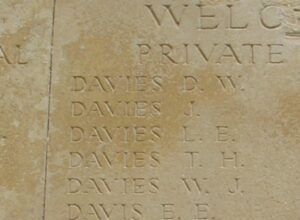
John Morris Davies, Sapper, 452460, Royal Engineers. John was born at Parkhen, Cilgerran in 1878, at the home of his maternal grandparents, Samuel and Esther Jones, the first child of David and Anne Davies. Prior to the war he lived at Monmouth. He enlisted at Cardiff into the Royal Engineers, and was posted to the Base Signal Depot. John served in East Africa with the East African Expeditionary Force, and he became ill there. He died on 3 January, aged 39, and is buried at Dar Es Salaam War Cemetery, East Africa.
David Griffith Edwards, Lance Corporal, 39954, East Lancashire Regiment. David was the son of William and Ann Edwards, of New Inn, Blaenffos. He enlisted at Cardigan into the Army Service Corps, with the Service Number T/4/145707. He later transferred into the 2/5th Battalion, East Lancashire Regiment, which was attached to 126 Brigade, 42nd (East Lancs.) Division. On 6 May 1915 the Division landed at Cape Helles, Gallipoli, where they fought until evacuation in January 1916. They then spent twelve months in Egypt, and were moved to the Western Front in February 1917, taking over the line near Épehy then Havrincourt. In September they moved north to Ypres, where they fought through Third Ypres, until moving to the Coast in September to refit. November 1917 saw them moving to positions at Givenchy, where they remained until moving back south in early 1918. Here they faced the German Spring Offensive of 21 March 1918 on the Somme, and saw heavy fighting. David was killed in action during the Battle of Bapaume on 24 March 1918, aged 22 (SDGW shows 31 March). He has no known grave, and is commemorated on the Pozieres Memorial, France.
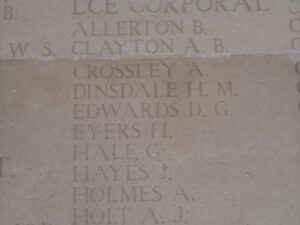
Vincent Jones Edwards, Private, 202783, Welsh Regiment. Vincent was born at Llanglydwen in 1898, the son of Thomas and Sarah Anne Edwards. The family later resided at Cilwendeg Gardens, Boncath, where Thomas and his two eldest sons, John and David, worked as Gardeners. Vincent enlisted at Carmarthen into the 9th Battalion, Welsh Regiment, which was attached to 58 Brigade, 19th (Western) Division. The Division assembled around Bulford during September 1914, and crossed to France during July 1915, moving to positions near Loos. The Division fought during the opening attack of the Battle of Loos, and then moved to the Somme, where they took part in the second wave of the attack on Ovillers-La Boiselle on 1 July 1916, capturing the village at heavy cost, and fought through the Somme Battles of Pozieres and the Ancre in 1916. They then moved North to Ypres, taking part in the Battle of Messines, and fought on the Menin Road and at Polygon Wood, before moving up to Broodseinde, Poelcapelle and Passchendaele Village itself. They then spent the winter in positions south of Cambrai, which is where Vincent was sadly wounded. He died of his wounds on 27 February 1918 and is buried at Hermies Hill British Cemetery, France.
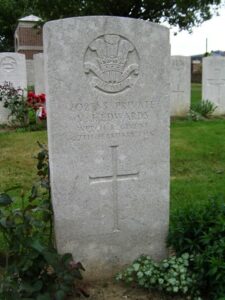
Arthur Owen Evans, Private, 6512, Australian Infantry. Arthur was born at Rhoshill, Pembrokeshire. He was the son of John and Elizabeth Evans, and had attended Bridell Council School. Arthur had emigrated to Australia prior to the war, and he enlisted during July 1916 at Victoria Barracks, New South Wales into the Australian Infantry. On 7 October 1916 Arthur embarked at Sydney aboard the S.S. Ceramic, bound for England, and he disembarked on 21 November at Plymouth. After a period of training at Salisbury Plain, Arthur embarked at Folkestone on 8 February 1917, and on arrival in France joined the 13th Battalion, A.I.F., attached to the 4th Australian Brigade, 4th Australian Division. The Division was still on the Somme, and followed the German withdrawal to the Hindenburg Line during March 1917. On 11 April 1917 the Division fought here at the Battle of Bullecourt, before being moved north to positions south of Ypres. Here, they fought at the Battle of Messines. It was here that Arthur was killed on 10 June 1917. He was 27 years old, and has no known grave, and so is commemorated on the Ypres (Menin Gate) Memorial, Belgium.
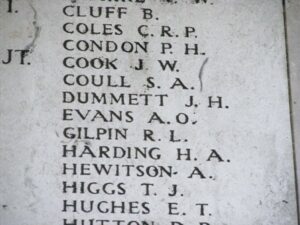
Thomas Evans, Corporal, 432900, Canadian Infantry. Thomas was born on 18 November 1877 the son of John and Mary Evans, of Tegryn. He had lived in London before the war, where he was a Policeman with the Metropolitan Police. Thomas emigrated to Canada prior to the war, and enlisted there at Edson on 21 January 1915 into the Canadian Infantry. Thomas sailed for England where he joined the 49th Battalion (Edmonton), which was attached to the 7th Canadian Brigade, 3rd Canadian Division. The Division formed in France during December, 1915. They moved to positions south of Ypres, and fought there in June 1916 at Mount Sorrel. They then moved south, taking up positions on the Somme during September, 1916 and they fought there at the Battle of Flers-Courcelette, at Thiepval, Le Transloy and on the Ancre. In April the Division fought during the Arras Offensive, at the Battle of Vimy Ridge, then during the Third Battle of the Scarpe and the Battle of Hill 70 near Loos, before moving back to Ypres. They fought here during Third Ypres, at the Second Battle of Passchendaele, where they successfully managed to capture Passchendaele Village. Thomas was killed in action here on 30 October 1917, aged 40. He is buried at Passchendaele New British Cemetery, Belgium.
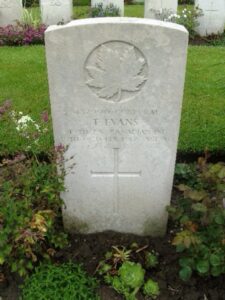
David Emrys George, Greaser, 912812, Mercantile Marine Reserve. Emrys was born in Laugharne in 1898, the son of Frank and Martha George. The family had moved to Pantyderi Mill, Blaenffos prior to 1911. Emrys served in the Mercantile Marine, aboard the H.M.S. ‘Derwent’. HMS Derwent was a River class destroyer which served with the Royal Navy. She was built by Hawthorn Leslie and launched in 1904. Derwent served in home waters during the Great War and was sunk by a mine of Le Havre on 2 May 1917. Emrys was drowned with the sinking of the ship that day. He was just 18 years old, and is commemorated on the Plymouth Naval Memorial, Devon.
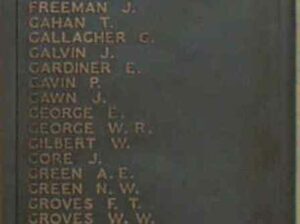
William Evan George, Private, 200653, Welsh Regiment. William was the son of Evan Griffith and Margaret George, of Maencoch, Blaenffos. He enlisted at Cardigan into the 1/4th Battalion, Welsh Regiment, which formed during August, 1914 at Carmarthen. The Battalion became attached to 159 Brigade, 53rd (Welsh) Division. The 53rd Division moved to the Mediterranean, sailing from Devonport in July 1915 arriving at Mudros by 5 August 1915. From here they moved to Gallipoli, landing on 9 August. Here they immediately faced the chaotic leadership that was to lead to the ultimate failure of the campaign, and spent the next few days in isolated pockets, fighting against a Turkish counter-attack during the Battle of Sari Bair, and then at the Attack on Scimitar Hill. The Division remained here throughout the coming months, and suffered severe losses in manpower strength during the great November 1915 blizzard on Gallipoli, when its total strength was reduced to less than that of a full-strength Brigade. On 11 December 1915 the Division was evacuated to Mudros, and by 23 December moved to Egypt. They remained on the Suez Canal Defences for the next twelve months, and in early 1917 moved into Palestine, where they remained for the duration of the war, fighting at the Battles of Gaza, and successfully capturing Jerusalem. William was killed during the First Battle of Gaza, on 26 March 1917. He was just 21 years old, and is commemorated on the Jerusalem Memorial, Israel.
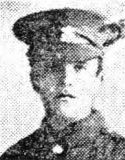
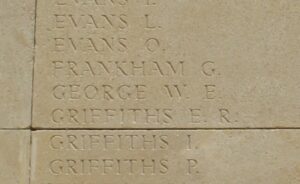
Haydn Griffiths, Private, 9845, Royal Fusiliers. Haydn was born at Llanfyrnach, the son of William and Sarah Griffiths, of Bwlchgwynt, Llanfyrnach. He enlisted at Merthyr into the 8th Battalion, Royal Fusiliers. The Battalion was attached to 36 Brigade, 12th (Eastern) Division. The Division landed at Boulogne on 31 May 1915, and took over the line at Ploegsteert Wood. They then moved south and fought in the Battle of Loos, and the subsequent actions of the Hohenzollern Redoubt, and remained there until March 1916. By June they were in position at the Somme, and attacked Ovillers on 2 July 1916. They then fought at Pozieres, which is where Haydn was killed in action on 3 August 1916, aged 20. Haydn has no known grave, and is commemorated on the Thiepval Memorial, France.
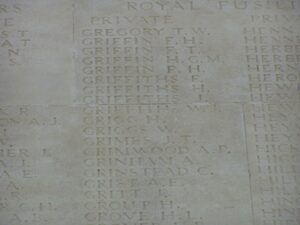
John Griffiths, Private, 302302, Manchester Regiment. John was born at Eglwyswrw, the son of Jacob and Mary Griffiths. The family later resided at Cwm, St. Dogmaels. John was the husband of Margaret Ann Griffiths, of Fairfield, St. Dogmaels. He enlisted at Cardiff into the 2/8th Battalion, Manchester Regiment, which was attached to 199 Brigade, 66th Division. The Division concentrated on the Western Front by 16 March 1917, moving to the Ypres sector. It was there, during the opening day of the Battle of Poelcappelle, that John was Killed in Action on 9 October 1917, aged 39. He is commemorated on the Tyne Cot Memorial, Belgium. (John is shown on the memorial as C. Griffiths).
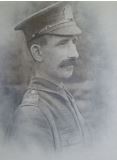
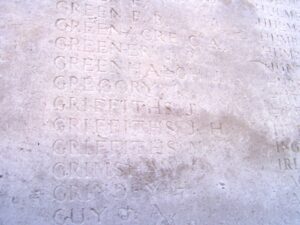
John Sidney James Havard, Private, 202031, South Lancashire Regiment. John was the son of David and Phoebe Havard, of College Green, Crymych. He enlisted at Crymych into the 2/4th Battalion, South Lancashire Regiment, which was attached to 172 Brigade, 57th (2nd West Lancs.) Division. The Division moved to France during February 1917, and moved to positions near Ypres, where they took part in the Second Battle of Passchendaele. In 1918 they took part in the 1918 Battle of the Scarpe, and at the Battle of Drocourt-Queant. John was wounded around this time, and evacuated, via the network of Casualty Clearing Stations, and via the Hospitals in France back to England for treatment. Sadly John died at home of his wounds on 28 October 1918. He was 25 years old and is buried at Bwlchygroes Calvinistic Methodist Chapelyard.
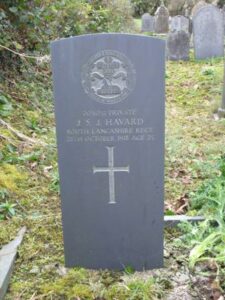
David Thomas Emyr James, Lieutenant, Mercantile Marine. David the son of Captain David and Annie James of St. Dogmaels, and the husband of Annie James, of 12, Earlsfield Road, Sefton Park, London. David served aboard the White Star Liner, R.M.S. Laurentic, which was requisitioned at the outbreak of war by the Admiralty, and converted to an Armed Merchant Cruiser. On the 25th January, 1917 the Laurentic was on a course to New York, carrying a cargo of 35 tonnes of Gold Bullion, when she struck a mine off Lough Swilly on the northern coast of County Donegal. She sank with the loss of 350 crew, among them was David James. He was 31 years old, and is commemorated on Panel 23 of the Plymouth Naval Memorial.
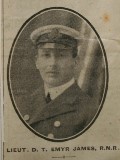
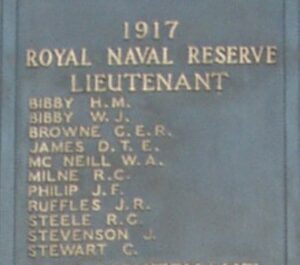
David James, MM, Lance Corporal, 613, Welsh Guards. David was the son of David and Ann James, of 6, Glogue Terrace, Glogue. He enlisted at Pentre into the Welsh Guards, and joined the 1st Battalion, attached to the 3rd Guards Brigade, Guards Division. This Division has the distinction of being formed in France in August 1915. The various Guards units that had been with other Divisions were withdrawn to be brought together to create this fine formation. It remained on the Western Front throughout the war and saw its first major action during the Battle of Loos on 25 September 1915, remaining in the area during the coming months, where they also fought in the subsequent Action of Hohenzollern Redoubt. In July 1916 the Division moved to the Somme, where they fought at the Battle of Flers-Courcelette, and then at the Battle of Morval, capturing Lesboeufs Village. David won his Military Medal for Bravery in the Field during the action at the Somme, but was sadly killed in action there on 16 September 1916. David was 23 years old, and is commemorated on the Thiepval Memorial, France.
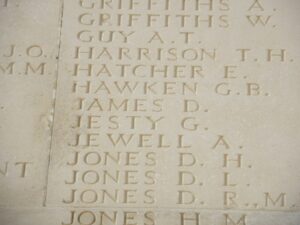
Joshua Clement James, Private, 202507, Welsh Regiment. Joshua was born at Eglwyswrw, the son of Samuel and Margaretta James, of Frochest Farm. He enlisted at Carmarthen into the 1/4th Battalion, Welsh Regiment, which was a Territorial Battalion, attached to 159 Brigade, 53rd (Welsh) Division. The division sailed for Alexandria in July 1915, and landed at Gallipoli on 9 August 1915. They suffered heavy casualties at Gallipoli, necessitating the Battalion to merge with the 1/5th Welsh to form the 4/5th Composite Battalion. After the evacuation of Gallipoli, the Division moved to Palestine. Joshua didn’t get sent overseas though. He Died on 23 February 1917, aged 29, and was buried in Eglwyswrw (St. Cristiolus) Churchyard.
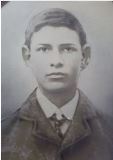
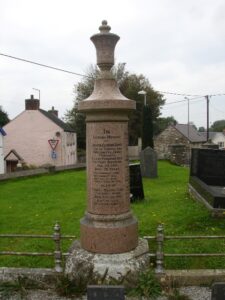
Peter William James, Driver, 42313, Royal Field Artillery. Peter was the son of William and Phoebe James, of Llanllyn, Hebron. He enlisted at Tonypandy in November 1914 into the Royal Field Artillery, and was posted to Preston, joining No. 2 Depot, Royal Field Artillery. At the end of the month Peter was posted to the 22nd Divisional Artillery, before being transferred to the 147th Brigade Ammunition Column, which was attached to the 29th Division. The Division initially sailed for Gallipoli, landing on 25 April 1915. Peter was wounded at Gallipoli on 30 April 1915, and was evacuated by Hospital Ship to the Military Hospital at Port Said. Peter Died of Wounds on 2 July 1915 aged 28, and is buried at Port Said War Memorial Cemetery, Egypt.
Benjamin David Jenkins, MM, Private, 31227, Royal Welsh Fusiliers. Benjamin was born at Boncath on 21 June 1894, the son of David and Sarah Jenkins. The family later moved to Jones Terrace, Pilot Street, St. Dogmaels. Benjamin enlisted at Carmarthen into the Royal Army Medical Corps in May 1915, with the service number 58253, but on 8 June was transferred to the 3rd Battalion, Royal Welsh Fusiliers. He was posted to France on 18 December 1915, and on 29 January 1916 was attached to the 1st Battalion, Royal Welsh Fusiliers, which was attached to 22 Brigade, 7th Division. The Division had been in France since the early days of the war, having returned back from Garrison duties around the Empire. Benjamin joined the battalion at Loos, before it marched southwards to take over positions on the Somme. The Division took part in one of the few successful attacks on the opening of the Battle on 1 July 1916, by taking the Village of Mametz, and fought on the Somme throughout the following months. It was whilst on the Somme, during the terrible winter holding the lines near the Ancre, when Benjamin was killed in Action, on 27 February 1917, aged 24. His body was lost in the muddy Ancre Valley, and so he is commemorated on the Thiepval Memorial, France. Benjamin was awarded the Military Medal for Bravery whilst in France, which was listed in the London Gazette of 10 October 1916, and was an award for the Somme.
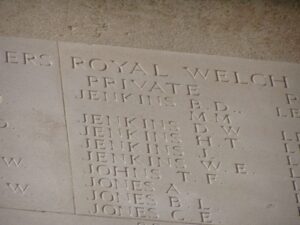
William Jenkins, Pioneer, 226584, Royal Engineers. William was born at Crymych, and by 1911 was widowed and living at Clynyfran with his children, working as a roadman. By the outbreak of war he lived at Clydach Vale, in the Rhondda Valley. He returned back to West Wales to enlist into the Royal Engineers at Carmarthen on 31 January 1917. He was posted to the 333rd Company, R.T.D., Royal Engineers. William was serving at Aldershot when he became ill and died of cerebro spinal fever at the Isolation Hospital on 23 July 1917, aged 47. At the behest of his eldest son, William, his body was brought home and buried at Crymych (Antioch) Congregational Chapelyard.
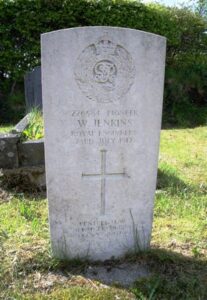
John Alfred Johnson, Private, 41567, Loyal North Lancashire Regiment. John was the son of John and Ruth Naomi Johnson, of Tynewydd, Star, Llanfyrnach. He enlisted at Cardiff into the 1/5th Battalion, Loyal North Lancashire Regiment, which was attached to 170 Brigade, 57th (2nd West Lancs.) Division. The Division moved to France during February 1917, and moved to positions near Ypres, where it took part in the Second Battle of Passchendaele. In 1918 it took part in the Battle of the Scarpe, and at the Battle of Drocourt-Queant. The Division fought on the Hindenburg Line during the Battle of the Canal du Nord, and it was during the advance to the Hindenburg Line and the Canal Du Nord that John was killed, on 30 August 1918. He was only 20 years old. John has no known grave, and is commemorated on the Vis-En-Artois Memorial, France.
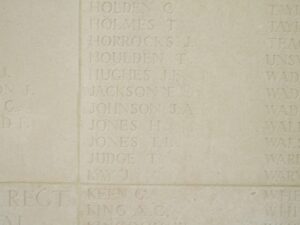
David Thomas Jones, Private, 1111, East Surrey Regiment. David was the son of John and Rachel Jones, of Hendy Farm, Blaenffos. He had married prior to the war, and lived with his wife Ann and their children at Church Cottage, Tonmawr, Pontrhydyfen, Glamorgan. David enlisted at Neath into the Army and was posted to the 7th Battalion, East Surrey Regiment, which was attached to 37 Brigade, 12th (Eastern) Division. The Division landed at Boulogne on 31 May 1915, and took over the line at Ploegsteert Wood. They then moved south and fought in the Battle of Loos, and the subsequent actions of the Hohenzollern Redoubt, and remained there until March 1916. David was wounded whilst in the line north of Loos, and was evacuated to the Military Hospital at Bethune for treatment. Sadly he died of his wounds here on 22 February 1916. David was 37 years old, and is buried at Bethune Town Cemetery, France.

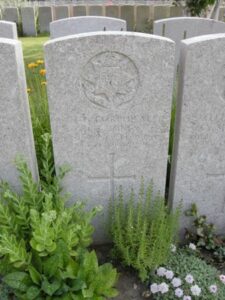
William Mathias Jones, Gunner, 118779, Royal Field Artillery. William was the son of Levi Thomas Jones and Anne Jones, of Nantgwyn, Blaenffos. He enlisted in the Village into the Army, and joined the Royal Field Artillery. William was posted to ‘C’ Battery, 108th Brigade, which served on the Western Front. The Brigade was at Ypres during 1917, taking part in the Battle of Third Ypres, when William was killed in action on 1 August 1917. He was 23 years old, and is buried at Potijze Burial Ground Cemetery, Belgium.
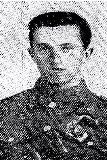
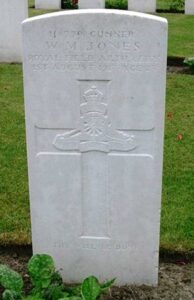
Thomas Richard Lewis, Private, 37060, East Yorkshire Regiment. Thomas was the son of Jonathan and Martha Lewis, of Winilan, Boncath. He enlisted at Llanelli into the Pembroke Yeomanry, with the Service Number 5189. After training he was posted to France, joining the 1st Battalion, East Yorkshire Regiment, attached to 64 Brigade, 21st Division. In the late summer of 1917 the Division moved to Ypres to take part in the Battle of Passchendaele, and later that year moved south to take part in the Battle of Cambrai. In 1918 the Division was in the St. Quentin area when the German Offensive hit, and suffered heavy casualties during the ensuing withdrawal. The Division then moved to Flanders to rest, but in April 1918 the Germans launched an offensive on the Lys. The Division was hit here, and fought at the Battle of Messines, 1918, and then the Second Battle of Kemmel. The Division was one of several that by now had become seriously weakened, and it was moved to a quiet French Sector near Soissons to rest. However, the Germans launched an offensive here, and the Division saw action again, during the Battle of the Aisne. In August, 1918 the British launched a series of offensives on the Somme, which were to ultimately lead to victory. The Division moved north, and took part in the Battle of Albert on 21 August 1918, which marked the start of the advance to victory. They then pushed east, and saw action at the Battle of Bapaume, the Battle of Epehy, and the Battle of the St Quentin Canal, which saw the mighty Hindenburg Line broken. Thomas was killed in action here on 27 September 1918. He was 27 years old, and is buried at Glageon Communal Cemetery Extension, France.
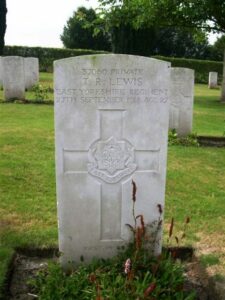
Walter Charles Little, Private, 320352, Welsh Regiment. Walter was the son of Walter and Mary Ann Little, of Springfield, Essex. After his father’s death in 1900, his mother remarried, moving to 3, Badeley Square, New Street, Chelmsford. Walter moved to West Wales and worked as a farm servant at Glandwr, Nevern prior to the war. He enlisted at Carmarthen into the Pembroke Yeomanry, with the Service Number 4688. The Pembroke Yeomanry formed at Tenby during August, 1914 as part of the South Wales Mounted Brigade, 1st Mounted Division. In 1916 they were sent to Egypt and guarded the Suez Canal Defences, but early in 1917 was disbanded, with the Battalion merging with the Glamorgan Yeomanry to form the 24th Battalion, Welsh Regiment, attached to 231 Brigade, 74th (Yeomanry) Division. The Division had formed in Egypt in January 1917 and had fought through the Palestinian Campaign, at the Battles of Gaza and the Battle and capture of Jerusalem. Due to the terrible casualties suffered by the British on the Western Front in March and April 1918 the Division was recalled to the Western Front, and arrived at Marseilles during May 1918. It fought at the Second Battle of Bapaume during the great offensive, and fought in Flanders before returning to the Somme and fighting at the Battle of Épehy, as part of the offensive towards the Hindenburg Line. Walter was wounded here, and evacuated to the Casualty Clearing Station at Doingt, where he sadly died of his wounds on 21 September 1918, aged 24. He is buried at Doingt Communal Cemetery Extension, France.
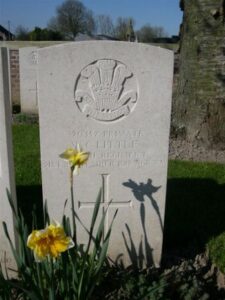
John Herbert Lloyd, Private, 38519, Gloucestershire Regiment. John was born at Eglwyswrw, the son of David & Elizabeth Lloyd, of Rofftcharles. He enlisted at Carmarthen, originally serving with the South Wales Borderers, but was transferred to the 8th Battalion, the Gloucestershire Regiment, which formed part of 57 Brigade, 19th (Western) Division. The 19th Division fought at Loos and the Somme, and then moved to Flanders, where they fought in the Battle of Passchendaele. It was on the opening day of the Battle of the Menin Road that John was Killed in Action, on 20 September 1917, aged 19. He is commemorated on the Tyne Cot Memorial.
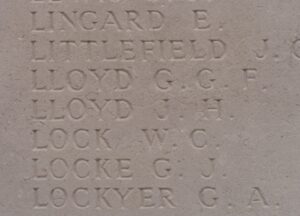
G. MacElroy. This man cannot presently be identified.
Idris Mathias, Rifleman, R/37992, King’s Royal Rifle Corps. Idris was born at Eglwyswrw in 1881, the son of David and Lydia Mathias. He married in 1905, and lived with his wife Hannah and daughter Winifred at 29, Evansfield Road, Llandaff. Idris enlisted at Cardiff into the 13th Battalion, King’s Royal Rifle Corps. The Battalion formed part of 111 Brigade, 37th Division. The Division concentrated in France between July and August 1915, and fought throughout the Battles of the Somme and the Battle of Arras, before moving to Flanders to take part in the Passchendaele Offensive. During the Battle of Polygon Wood, Idris was Killed in Action, on 29 September 1917, aged 36. He has no known grave, and is commemorated on the Menin Gate Memorial at Ypres.
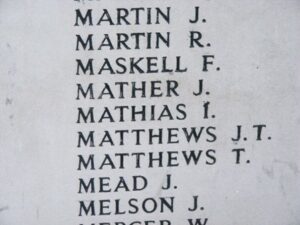
Thomas Morgan, Lance Corporal, 8933, Welsh Regiment. Thomas was born in Egremont in 1888, the son of David and Charlotte Morgan. By 1901 the family was residing at Crick, near Rugby. Thomas enlisted at Llandeilo into the 2nd Battalion, Welsh Regiment, which was attached to 3 Brigade, 1st Division. The Division was one of the first British Divisions in France, fighting at the opening Battle of Mons, and retreating south to the Marne, where the German Advance was held. The Germans withdrew northwards across the Aisne to regroup, and the Allies cautiously followed, taking part in the Battle of the Aisne. Thomas was Killed in Action on the Aisne on 14 September 1914, aged 26, and is commemorated on the La Ferté-Sous-Jouarre Memorial, France.
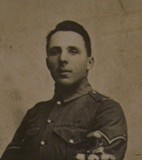
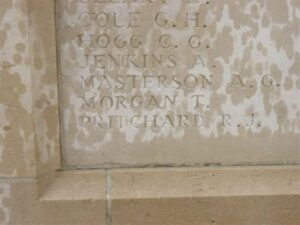
Haydn Gwion Morris, Sapper, 155380, Royal Engineers. Haydn was the son of William and Sarah Morris, of Bridge Hill, Hebron. He enlisted at Carmarthen into the Royal Engineers, and was posted to their ‘P’ Special Company, a Chemical Warfare Company. The Germans had introduced the use of chemical warfare at Ypres, attacking French Colonial positions near Langemarck on 22 April 1915. Outraged, and after several more similar attacks, the British formed their own Gas Companies, and developed gases and the means of delivering them. The Special Companies were developed to handle and fire the 4 inch Stokes Mortar Gas Shells, which were normally used prior to an infantry attack. Haydn was Killed in Action during the Third Battle of the Scarpe, on 6 May 1917 aged 23, and is buried at Beaulencourt British Cemetery, Ligny-Thilloy.
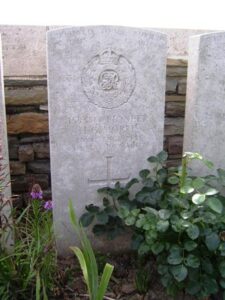
Reginald Thomas Morshead, Driver, 4165, Royal Field Artillery. Reginald was born at Devonport, and was the Husband of Charlotte Morshead, of Star Cottage, Llanfyrnach. He enlisted at Pentre into the Royal Field Artillery, and was posted to the Western Front with “A” Battery, 52nd Brigade, attached to the 9th (Scottish) Division. During the summer of 1915 the Division moved to France, and saw its first major action during the Battle of Loos. They then took part in the Battle of the Somme, fighting at the opening Battle of Albert, and then at the Battle of Bazentin, where they captured Longueval. They then fought at the Battle of Delville Wood, and the Battle of Le Transloy, and in April, 1917 were at Arras, where they fought at the First Battle of the Scarpe and the Third Battle of the Scarpe. Reginald was killed at Arras on 12 April 1917. He was 35 years old, and is buried at St. Nicholas British Cemetery, France.
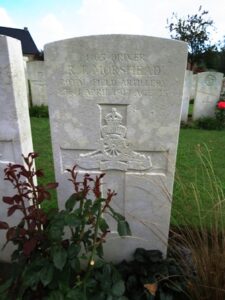
David Morris Owen, Private, 202676, Welsh Regiment. David was born at Clydey, near Llanfyrnach, the son of James and Anne Owen, of Glasfryn, Clydey. He enlisted at Llanelli into the army, and was posted to the 9th Battalion, Welsh Regiment, which was attached to 58 Brigade, 19th (Western) Division. The Division assembled around Bulford during September 1914, and crossed to France during July 1915, moving to positions near Loos. The Division fought during the opening attack of the Battle of Loos, and then moved to the Somme, where they took part in the second wave of the attack on Ovillers-La Boiselle on 1 July 1916, capturing the village at heavy cost, and fought through the Somme Battles of Pozieres and the Ancre in 1916. They then moved North to Ypres, taking part in the Battle of Messines, and fought on the Menin Road and at Polygon Wood, before moving up to Broodseinde, Poelcapelle and Passchendaele Village itself. The Division was moved south to the Arras area over the winter of 1917/1918. David took ill here and sadly died on 4 March 1918, aged 23. He is buried at Rocquigny-Equancourt Road British Cemetery, Manancourt, France.
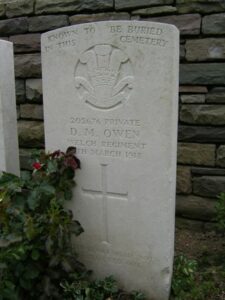
Griffith Phillips, Private, 56891, Welsh Regiment. Griffith was born in Eglwyswrw, the son of Evan and Ellen Phillips, of Pantycelyn. He enlisted at Neath into the Pembroke Yeomanry on 9 December 1915, and on 4 August 1916 was posted to France, joining the 13th Battalion, Welsh Regiment, which was attached to 114 Brigade, 38th (Welsh) Division. The Division landed in France in December, 1915, and was blooded at the Battle of Mametz Wood, where it suffered so badly that it was not used again for a year. It took part in the Passchendaele Offensive, at the Battle of Pilckem Ridge, on 31 July 1917, and then fought at Langemarck. The Division was in the French Flanders sector at the end of 1917, and it was during a tour in the front line near Fleurbaix that Griffith was killed in action, on 1 January 1918, aged 37. He is buried in Rue-Petillon Military Cemetery, France.
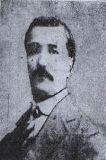
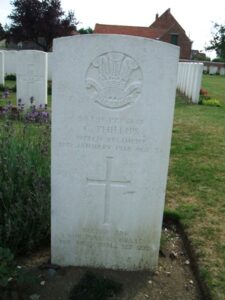
Haydn Phillips, Private, 29933, South Wales Borderers. Haydn was born in Eglwyswrw, and enlisted at Porth, into the South Wales Borderers. He was posted to France early in 1916, joining the 2nd Battalion, South Wales Borderers, which had moved to France in March 1916 from Egypt, with 87 Brigade, 29th Division. The Battalion had fought at Tsingtao, China, and had taken part in the Gallipoli campaign, landing at Cape Helles on 25 April 1915. The battalion saw heavy losses on 1 July 1916 at Beaumont Hamel, and after rebuilding strength, saw heavy fighting during later actions on the Somme in 1916. During 1917 the battalion fought at, Passchendaele and Cambrai, but at some time during the fighting in France, Haydn took ill, and was shipped back to Hospital in the UK. He died in hospital at Whitechapel, London on 18 March 1918, aged 20, and is buried in Pontyglazier (Bethabara) Baptist Chapelyard.
Evan Rees, Private, 73644, Royal Welsh Fusiliers. Evan was the son of David and Sarah Rees, of Giblin Cenarth, Ponteuney, Newcastle Emlyn. He enlisted at Carmarthen into the 9th Battalion, Royal Welsh Fusiliers, who were attached to 58 Brigade, 19th (Western) Division. The Division crossed to France during July 1915, and moved to positions near Loos. The Division fought during the opening attack of the Battle of Loos, and then moved to the Somme, where they took part in the second wave of the attack on Ovillers-La Boiselle on 1 July, capturing the village at heavy cost, and fought through the Somme Battles of Pozieres and the Ancre in 1916. They then moved North to Ypres, taking part in the Battle of Messines, and fought on the Menin Road and at Polygon Wood, before moving up to Broodseinde, Poelcapelle and Passchendaele Village itself, before moving to the Somme area to rest and rebuild. Evan was killed in action on the Somme on 4 January 1918, aged 23. He has no known grave, and so is commemorated on the Thiepval Memorial.
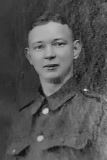
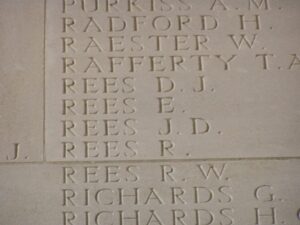
Oliver James Rees, Private, 32954, Welsh Regiment. Oliver was born in 1880, the son of John and Mary Rees, of Glyn, Eglwyswrw. By 1901 he was residing at Pontycymmer, with Ellen Jones, and worked as a coalminer there. In 1903 he married his widowed landlady, Ellen, of 32, Bridgend Road, Pontycymmer. Oliver enlisted at Bridgend into the 9th Battalion, Welsh Regiment. The battalion was attached to 58 Brigade, 19th (Western) Division, and landed in France during July 1915, taking up a sector north of Loos, near Givenchy. It was during the Divisions first major engagement, at the Battle of Loos, that Oliver was Killed in Action on 25 September 1915, aged 35. He is commemorated on the Loos Memorial, France.
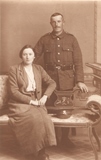
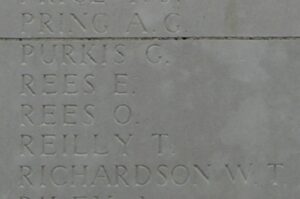
Benjamin Samson, Lance Corporal, 4118, Australian Imperial Force. Benjamin was born at Henllan Amgoed, the son of David Samson, of Trefedw, Hebron. Benjamin and his brother David (See below) emigrated to Australia, where they found work as miners at Collie. Ben attested on 11 May, 1916 into the Australian Imperial Force at Belmont, Western Australia. On 5 September 1916 Ben was assigned to the 10th Reinforcements to the 32nd Battalion, and embarked at Fremantle aboard H.M.A.T. Port Melbourne, bound for the U.K. on 28 October that year. On 1 March 1917 Ben arrived at Etaples from England, and joined his Battalion on 6 March. He was promoted to Lance Corporal on 9 April, and the Battalion, as part of 8 Brigade, 2nd Australian Division, moved to Flanders, where they fought at the Battles of Third Ypres. It was during the Battle of Polygon Wood that Ben was Killed in Action on 30 September 1917, aged 32. A German aeroplane had come down near the Australian lines, and German Artillery was trying to break it up with shellfire, when a shell landed in a dugout occupied by Ben. He was buried on the spot by some of his ‘mates’, and his body was later reinterred at Tyne Cot Military Cemetery.
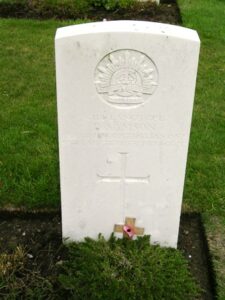
David Samson, Private, 3548, Australian Imperial Force. David was the brother of Benjamin (see above), and enlisted at Blackboy, Western Australia, into the Australian Imperial Force on 23 July 1915. David embarked as part of the 11th Reinforcements of the 16th Battalion at Adelaide on 27 October, 1915 aboard H.M.A.T. Benalla, and arrived in Egypt by February 1916. He had several spells of sickness in Egypt, requiring Hospital treatment, but was fit enough by June 1916 to embark aboard the H.S. Arngow and travel to England. He embarked to France in September 1916 after a spell at Larkhill Camp, and joined the 16th Battalion in the field on 1 October 1916, missing the fighting at Pozieres, and spent the winter of 1916/1917 entrenched near Flers on the Somme. David was Killed in Action near Flers on 11 April 1917 aged 24. His body was lost on the battlefield, and so he is commemorated on the Villers Brettoneux Memorial.
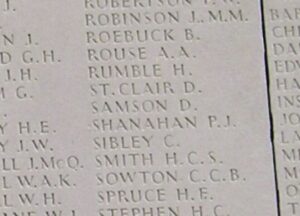
Benjamin Taylor, Sapper, 107552, Royal Engineers. Benjamin was the son of George and Sarah Ann Taylor, of Glandulais, Manordivy. He enlisted at Fishguard into the Royal Engineers on 16 November 1915, and was posted to France on 20 November 1916, joining the 7th Field Company, Royal Engineers, which was attached to the 50th (Northumbrian) Division. During the summer of 1916 the Division was on the Somme, and fought at the Battle of Flers-Courcelette, the Battle of Morval and the Battle of Le Transloy. After spending a winter on the Somme, it moved north to Arras, and took part in the Arras Offensive of April 1917, capturing the Wancourt Ridge. It was then posted north to Ypres, fighting at the Second Battle of Passchendaele, and remained there for the winter. During March 1918 the Division was stationed near St. Quentin, and was hit by the German Spring Offensive of 21 March 1918. After taking part in a gallant rearguard action during the Actions at the Somme Crossings, the Division moved north to Flanders to rest and rebuild, but in April the Germans launched an attack in Flanders, around the Lys, and the Division saw heavy fighting again. The Division was then transferred to IX Corps, on the Aisne, believed to be a much quieter area. This was unfortunately not the case, as the Division was hit hard by a surprise enemy attack, and fought at the Battle of the Aisne, 1918. Benjamin was taken Prisoner by the Germans here on 27 May 1918. He died of exhaustion as a Prisoner of War aboard a transport train to Langensalza on 9 October 1918, aged 23. He is buried at Niederzwehren Cemetery, Germany.
David Thomas, Private, 5166, Lancashire Fusiliers. David was the son of Enoch and Rachel Thomas, of Castell Clydey, Llanfyrnach. He enlisted at Cardiff into the Army, and was posted to the 2/8th Battalion, Lancashire Fusiliers, attached to 197 Brigade, 66th (2nd East Lancs.) Division. This 2nd-Line Territorial Division was formed in war time, following the authorisation of the raising of 2nd-Line units on 31 August 1914. Men were enlisted for the reserve units of the 1st-Line (East Lancashire Division, eventually redesignated the 42nd) from September 1914 onwards. Men of the 1st-Line who did not undertake the imperial service obligation were transferred to these reserves. The reserve units were formed up into a 2nd-Line Division, initially called the 2nd East Lancashire, from early 1915. Early clothing and equipment for these units was haphazard; many had to train in civilian clothes, and it was only from very late 1915 that proper equipment was received. In particular, training of this Division was slowed by a continual drain of men for drafts to replace casualties incurred by the 1st-Line Division on Gallipoli. David sadly died of malaria on 3 September, 1916. He was 23 years old, and is buried at Bwlchygroes Calvinistic Methodist Chapelyard.
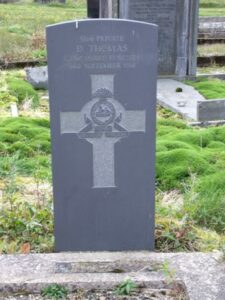
David Thomas, Sapper, 448274, Royal Engineers. David was born at Eglwyswrw in 1887, the son of Thomas and Ellen Thomas. The family moved to 102, Sandy Road, Llanelli prior to 1911. David married Agnes Thomas in 1908, and the couple resided at 9, Marine Street, Llanelli. He enlisted at Llanelli into the Royal Engineers, and served with the 436th Field Company. David was killed in action during the Battle of Nabi Samweil on 26 November 1917, aged 30, and is remembered on the Jerusalem Memorial, Israel.
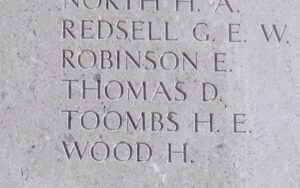
Simon Thomas, Sapper, 82332, Royal Engineers. Simon was the son of Daniel and Mary Thomas, of Pontsaeson, Eglwyswrw. He was living at Neath by 1901, and had married Blodwen Rowlands at Glynneath in 1902, the couple later having two children. Simon enlisted at Neath into the Royal Engineers. He was posted to the 124th Field Company, attached to the 38th (Welsh) Division. Simon landed in France with his unit on 3 December 1915, and moved with the Division to the Fleurbaix sector, near Armentieres. This was known as the ‘Nursery Sector’, which was a quieter sector of the Western Front, used for blooding new troops into trench warfare. Although quieter, it was far from safe, and Simon was killed in action here on 3 April 1916, aged 39. He has no known grave, and is commemorated on the Loos Memorial, France.
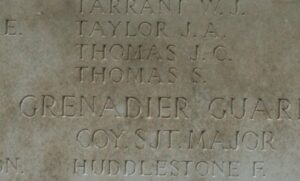
Thomas Walter Thomas, Lance Corporal, 28552, Royal Inniskilling Fusiliers. Thomas was the son of Thomas and Hannah Thomas, of Pencnwcmawr, Eglwyswrw. He enlisted at Leamington into the Welsh Regiment, with the Regimental Number 39547. Thomas later transferred into the 7th Battalion, Royal Inniskilling Fusiliers, attached to 49 Brigade, 16th (Irish) Division. During December 1915 the Division moved to France and concentrated in the Bethune area. They were still in the area when Thomas was killed on 27 April 1916, aged 23. He has no known grave, and is commemorated on the Loos Memorial, France.
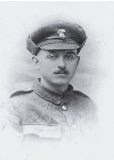
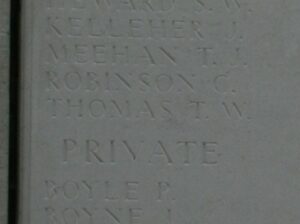
William Thomas, Private, 48948, Royal Army Medical Corps. William was born at Cilgerran, the son of David and Margaret Thomas. He spent four years as a pupil teacher at Cilgerran school before going on to Cardigan Intermediate School and then spent a period at Carmarthen Training College. After qualifying as a teacher he was appointed headmaster at Henry’s Moat School in Pembrokeshire. Having worked there for eighteen months he was promoted to headmaster of Llanddewi Velfry School, where he spent five years before enlisting at the end of 1915. He was posted to F Company, Royal Army Medical Corps, which was a training company based at Redan Hill, Aldershot. He married Daisy Victoria Thomas, a fellow teacher, from Narberth on 1 January 1916. Not much is known of William’s time at war, but he returned home to Narberth on 11 March 1916 suffering from ill health, and sadly died at home of sickness on 22 March 1916, aged 27. William is buried at Narberth Cemetery. His widow Daisy married William Griffiths Mathias after the war. Their only son, Flying Officer John Edward Mathias, DFC, was killed on 27 April 1944. The photograph of William and Daisy is courtesy of Michael Cullen.
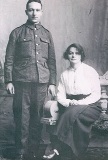
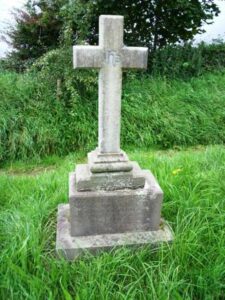
Richard Gomer Tudor, Sergeant, 18258, South Wales Borderers. Richard was the son of Martha and the late Samuel Tudor, of Hebron, and he enlisted at Newport into the 5th Battalion, South Wales Borderers. The Battalion was formed at Brecon in September 1914 and attached to 58 Brigade, 19th (Western) Division. The Division assembled around Bulford during September 1914. Divisional training was completed near Tidworth, from March 1915, and the Division crossed to France during July 1915, moving to positions near Loos. The Division fought during the opening attack of the Battle of Loos, and then moved to the Somme, where they took part in the second wave of the attack on Ovillers-La Boiselle on 1 July, capturing the village at heavy cost, and fought through the Somme Battles of Pozieres and the Ancre in 1916. Richard was wounded on the Ancre, and died as a result on 18 November 1916. He was 23 years old, and was buried at Contay British Cemetery, Contay, France.
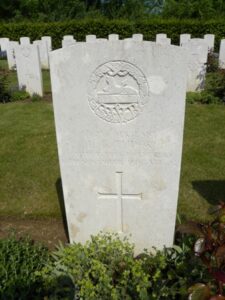
Sidney David Watkins, Private, 74251, Kings Liverpool Regiment. Sidney was born at Dudley in 1898, the son of David and Jane Watkins. By 1909 the family was residing at Penraltyfelyn, Cilgerran. Sidney enlisted at Cardiff into the Army, and was posted to the 19th Battalion, King’s Liverpool Regiment, which formed at Liverpool in August 1914. On 30 April 1915 the Battalion was attached to 89 Brigade, 30th Division. The Division moved to France in November 1915, and took part in its first major action during the Somme Offensive, at the Battle of Albert, where they captured Montauban. They then fought during the latter stages of the offensive, during the Battle of Le Transloy, before wintering on the Somme. In March 1917 the Division followed the German Retreat to the Hindenburg Line, and in April took part in the First Battle of the Scarpe, and then at the later Second Battle of the Scarpe. Later that year they were moved north to Ypres, and fought at the Battle of Pilckem. Sidney must have been wounded in France, and was medically downgraded and attached to the 84th Company, Labour Corps, with his Service Number changing to 50245. Sidney was wounded whilst at Cambrai during early January 1918 and was evacuated to a Hospital near Boulogne where he died of wounds on 18 January 1918. Sidney was just 19 years old, and is buried at Wimereux Communal Cemetery, France.
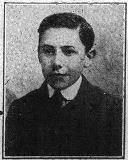
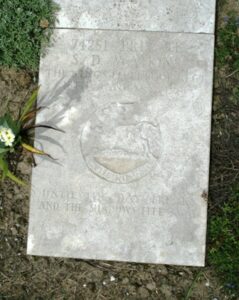
Bryn Gwynne Williams, Private, 67515, Cheshire Regiment. Bryn was the son of John and Mary Williams, of Deri House, Eglwyswrw. He worked as a Bank Clerk, and was living at 105, Priory Street, Carmarthen by 1917. He enlisted at Carmarthen into the Welsh Regiment on 10 September 1917. Bryn was then posted to the 48th Training Battalion, and on 3 April 1918 was posted to France, joining the 9th Battalion, Cheshire Regiment, which was attached to 56 Brigade, 19th (Western) Division. The Division was in Flanders, rebuilding from its mauling on the Somme, following the German offensive which began on 21 March 1918. It had then been sent to Messines, to rebuild, but was caught up in the German attack at Messines, which was launched on 7 April 1918 by the Germans. Bryn by now had become dangerously ill, and had been evacuated to the Base Hospital at Étaples for treatment. He sadly died there of pneumonia on 23 April 1918, aged 18. He is buried at Étaples Military Cemetery, France.
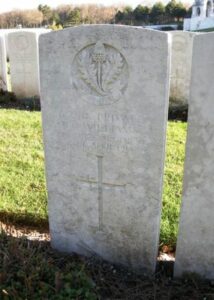
David Thomas Wooldridge, Guardsman, 24726, Grenadier Guards. David was born in 1894, the son of George and Jane Wooldridge, of Newchapel, Boncath. He enlisted at Cardigan into the Grenadier Guards, and was posted to the 3rd Battalion, which was attached to the 2nd Guards Brigade, Guards Division. This Division has the distinction of being formed in France in August 1915. The various Guards units that had been with other Divisions were withdrawn to be brought together to create this fine formation. It remained on the Western Front throughout the war and saw its first major action during the Battle of Loos on 25 September 1915, remaining in the area during the coming months, where they also fought in the subsequent Action of Hohenzollern Redoubt. In July 1916 the Division moved to the Somme, where they fought at the Battle of Flers-Courcelette, and then at the Battle of Morval, capturing Lesboeufs Village. They remained here for the winter, and in March 1917 took part in the advance caused by the German Retreat to the Hindenburg Line. Later that year they moved north to Ypres, where they fought at the Battle of the Pilckem Ridge. David was killed in action here on 31 July 1917, aged 23. He has no known grave, and is commemorated on the Ypres (Menin Gate) Memorial, Belgium.
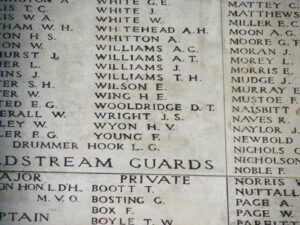
World War Two, 1939-1945
Henry Peris Davies, Second Lieutenant, 164971, Royal Artillery. Henry was the son of Evan and Anne Davies, and served with 5 Field Regiment, Royal Artillery. Henry was most killed during the Japanese invasion of the Malayan peninsula on 31 December 1941. He was 27 years old, and is commemorated on the Singapore Memorial, Singapore.
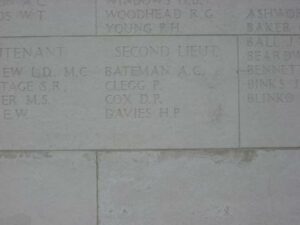
R. Evans. This man cannot be positively identified, but may be the man below who was killed locally:
Robert Evans, Flight Sergeant, 1475549, Royal Air Force Volunteer Reserve. Robert served as a Wireless Operator/ Air Gunner with 547 Squadron, Royal Air Force. The Squadron was attached to Coastal Command, equipped with the Vickers Wellington, and was used for anti-shipping duties, then anti-submarine duties, beginning patrols from south-west England in June. At the end of October 1943, it changed to Liberators, and a year later moved to Scotland, where patrols were mixed with attacks on enemy shipping off the Danish and Norwegian coasts. Robert was killed when his Liberator, Serial EV881, crashed near Mynachlog Ddu whilst on a training exercise on 19 September 1944. He is buried at Haverfordwest (City Road) Cemetery.
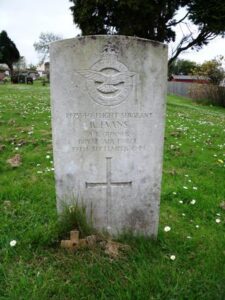
William George Evans, Private, 3709517, The King’s Own Royal Regiment (Lancaster). William was the son of Isaac and Mary Evans, and served with the 1st Battalion, King’s Own Royal Regiment. At the outbreak of war, the battalion was stationed at Karachi. William died here on 28 October 1940, and is buried at Karachi War Cemetery, Pakistan.
David John Griffiths, Private, 14600905, Royal Berkshire Regiment. David was the son of David and Esther Maranetta Griffiths of Crymych, and the husband of Gwendolen Beatrice Griffiths, of South Croydon, Surrey. He served with the 10th Battalion, Royal Berkshire Regiment during the North African campaign, and during the invasion of Sicily and Italy in 1943. David was killed in Italy on 8 February 1944. He was 34 years old, and is buried at Beach Head War Cemetery, Anzio, Italy.
Daniel Alcfryn James, Private, 1771319, Welch Regiment. Daniel was the son of Joseph and Lena James, of Eglwyswrw, and the husband of Daisy Maude James, of Newport, Pembrokeshire. He served with the 1st Battalion, Welch Regiment. The battalion served in the North African campaign after rebuilding following heavy casualties during the fall of Crete, and suffered terribly at Benghazi, losing almost 500 men. It then rebuilt, and took part in the subsequent invasion of Sicily and Italy. The 1st Welch then transferred to the elite 1st Guards Brigade, and took part in heavy fighting around the Argenta Gap. Dan was killed in Italy during the drive towards the River Po on 21 April 1945, aged 28. He is buried in Faenza War Cemetery, Italy.
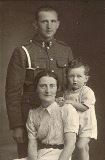
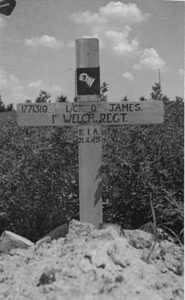
William Richard Jenkins, Able Seaman, Merchant Navy. William was the son of John and Blodwen Jenkins, of Blaenconin Cottage, Llandissilio. He served with the Merchant Navy aboard the Cardiff registered steamer SS Porthmeor. William drowned when Porthmeor sunk after a collision in St. George’s Channel on 20 August 1941. He was 19 years old, and is commemorated on the Tower Hill Memorial, London.
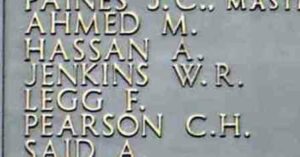
Oliver James Jones, Second Officer, Merchant Navy. Oliver was the Husband of Irene C. Jones, of Cilgerran, and served in the Merchant Navy as Second Officer aboard the MV Frederick S. Fales, a Hong Kong registered tanker. She was part of Convoy HX72 in September 1940, which comprised of 42 ships, carrying materials to the United States. On the night of 21 September the convoy was spotted and attacked by the a Wolf Pack of five German U-Boats, led by Germany’s most famous submariner, Gunther Prien, the man who had so audaciously crept into Scapa Flow to sink the Battleship Royal Oak in 1939. After several losses among its fleet, the convoy was again hit in the early hours of the 22 September 1940, with U-100 firing a salvo of torpedoes at the Frederick S. Fales, sending her down with the loss of 20 of her crew of 48 men. One of the lost men was Oliver. He was 35 years old, and is commemorated on the Tower Hill Memorial, London. This had been the first use of the Wolf Pack technique on a British Convoy, and it had been proved successful, with ten ships lost and a further three damaged.
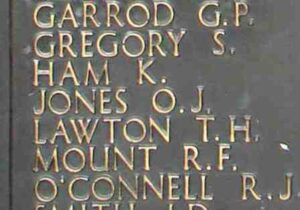
William Joseph Jones, Gunner, 1605162, Royal Artillery. William was born at Treorchy on 25 September 1914 and resided at Llwynbanal, Hebron prior to the war. He enlisted into the Royal Artillery soon after the outbreak of war and embarked for Singapore to join the 3rd Heavy Anti-Aircraft Regiment, Royal Artillery, which was attached to Malaya Command. Singapore was the foremost British military base and economic port in South–East Asia and was known as the ‘Gibraltar of the East’. It was strongly garrisoned and was thought to be impregnable. On 8 December 1941 the Japanese launched a series of simultaneous attacks against Pearl Harbour, Malaya, Thailand and the Pacific Islands. The Japanese had a force of some 30,000 troops involved in the Malayan invasion but soon reached the outer defences of Singapore following a short period of intense fighting. General Percival, commanding a garrison of some 85,000 troops in Singapore was ordered by Winston Churchill to fight to the last man, however, on 15 February 1942 he surrendered, and 80,000 troops were marched into captivity. William was taken into captivity that day, along with his fellow survivors, and was initially incarcerated in Changi. On 18 October 1942 he was sent with the 600 Gunners Party to Ballale Island to construct an airfield, but died, or was killed, as a POW on or just after 5 March 1943. The 27-year-old has no known grave and is commemorated on the Singapore Memorial, Singapore. The remains of the gunners of the 600 party who were later found were laid to rest 12 miles north of Port Moresby, Papua New Guinea.
Ivor Wells Lewis, Bombardier, 808595, Royal Artillery. Ivor was the son of Albert E. Lewis and Elizabeth Lewis of Crymych. He married Betsy Mary Mira Phillips at Crymych in the summer of 1939, and the couple set up home at Hayes, Middlesex. Ivor was probably based here with the 135 (The Hertfordshire Yeomanry) Field Regiment, Royal Artillery. The Regiment remained in the United Kingdom until 1941 when it was sent to India, joining the 18th Indian Division, and was deployed to Singapore. Ivor was killed on 11 February 1942, during the heavy fighting which led to the fall of Singapore four days later. He was 27 years old, and is buried at Kranji War Cemetery, Singapore. Ivor is also commemorated on his parents grave at Crymych.
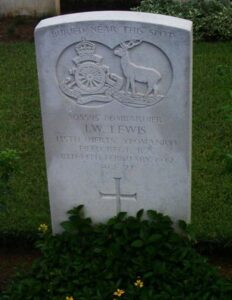
Ernest James Lloyd, Private, 14572565, The Wiltshire Regt (Duke Of Edinburgh’s). Ernest was the son of Emrys and Margaret G. Lloyd, and the husband of Sarah Margretta Lloyd, of Crymych. He served with the 6th Battalion, Wiltshire Regiment during the North African campaign, and during the invasion of Sicily and Italy in 1943. Ernest was killed in Italy on 9 May 1944. He was 24 years old, and is buried at Beach Head War Cemetery, Anzio, Italy.
John Vincent Lloyd, Fusilier, 4196126, The Royal Welch Fusiliers. John was the son of John and Hannah Lloyd, of Newcastle Emlyn, and served with the 2nd Battalion, Royal Welch Fusiliers. The battalion was stationed in India at the outbreak of war, moving via South Africa to Madagascar. John died in Madagascar on 6 May 1942. He was 23 years old, and is buried at Diego Suarez War Cemetery, Madagascar.
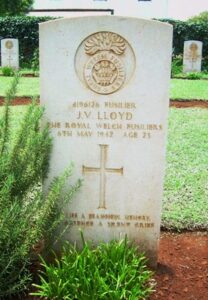
Benjamin Edwin Nicholas, Leading Aircraftman, 526309, Royal Air Force. Benjamin was the son of William Nicholas, and of Sarah Nicholas, of Tegryn, and served with 228 Squadron, Royal Air Force. The Squadron was a flying boat unit, which carried out anti-submarine and shipping patrols in the Mediterranean from its base at Kalafrana in Malta from October 1940. Benjamin was killed when his Short Sunderland N9020/W was lost over the Mediterranean on 1 November 1940 after being shot down by two Italian fighters. Benjamin was 24 years old, and is commemorated on the Alamein Memorial, Egypt.
Eilir Rees, Able Seaman, D/JX 392995, Royal Navy. Eilir was the son of Mr. and Mrs. G. T. Rees, of Bwlch-y-Groes, and served with the Royal Navy at HMS President III, the Royal Naval Accounting Base, which trained men to serve aboard defensively armed merchant ships (DEMS). Eilir was then posted to the SS Madoera, a Dutch Steamship. Eilir died when Madoera was lost at sea on 24 February 1943. He was 19 years old, and is commemorated on the Plymouth Naval Memorial, Devon.
George Rumble, Corporal, 7879212, Royal Armoured Corps. George was the son of Alfred and Anne Rumble, and the husband of Faith Rumble, of Cardigan. He served with the 7th Royal Tank Regiment, Royal Armoured Corps, which moved to North Africa by December 1940, as part of the British Western Desert Force. The 7th RTR contained Matilda infantry tanks and operated in support of the 11th Indian Infantry Brigade, 4th Indian Infantry Division. The regiment attacked and destroyed the Italian Maletti Group at the Nibeiwa Camp in its first major action in December 1940, killing General Maletti in the process. George was killed during the fighting on 9 December 1940. He was 35 years old, and is buried at Halfaya Sollum War Cemetery, Egypt.
D. Thomas. Cannot presently be identified.
Thomas David Thomas, Gunner, 1605265, Royal Artillery. Thomas was the son of Thomas and Catherine Thomas, of Hebron, Carmarthenshire. He served in the 3rd Heavy Anti Aircraft Regiment, Royal Artillery, which was based in the Far East. Thomas had been captured by the Japanese, and was sent to work on the Burma-Siam Railway. Sadly Thomas died in captivity in Burma, on the 6th December, 1943 aged 30. Thomas is buried at Thanbyuzayat War Cemetery, Myanmar.
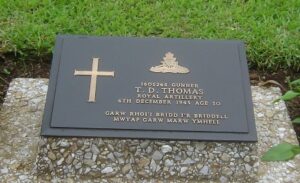
Leonard Woolridge, Private, 4924190, Alexandra, Princess of Wales’ Own Yorkshire Regiment. Leonard was the son of Ernest George and Jane Woolridge. He served with the 7th Battalion, Yorkshire Regiment, which landed on the Normandy beaches on D-Day, 6 June 1944. Leonard was killed in action during the Normandy landings that day. He was 34 years old, and is buried at Bayeux War Cemetery, France.
